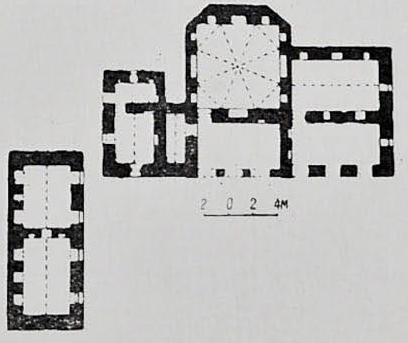On 23 July 1993, following the occupation of Agdam by Armenian armed forces, Imaret Complex where the Palace of Panah Ali Khan, the founder of the Karabakh Khanate was located, had undergone vandalization. On 20 November 2020, with the liberation of Aghdam from Armenian occupation, the historical heritage of the Karabakh khans were under reconstruction. Qarabag.com has prepared material about the history of formation and architectural structure of the summer residence of the Karabakh Khan in Agdam.
The residence of the first Karabakh Khan, Panah Ali Javanshir is located in Imaret Complex near the city of Agdam. The Khan Palace was built by Panah Ali Khan, the founder of the Karabakh Khanate, in 1754-1759.
[“Yevlakh-Shusha: Archaeological sketch” /J.Alexandrovich, I.Azimbekov, M.Sysoyev /News of the Azerbaijan Committee for the Protection of Monuments of the Country, Art and Nature; Azkomstaris.1928 3. P. 7]
However, the plaque that was installed in Soviet years, included the following statement:
“The estate of Panah Ali Khan. In 1750, Panah Khan moved his residence from Bayat Fortress to the outskirts of Agdam near Shahbulag. This house was built of stone brought from Shahbulag in 1751“.
 Azerbaijani art critic A.V. Salamzadeh describes the residence of Panah Ali Khan of Karabakh as follows:
Azerbaijani art critic A.V. Salamzadeh describes the residence of Panah Ali Khan of Karabakh as follows:
“The Palace of Panah Khan near Aghdam, which has come down to us in a badly destroyed state, introduces us to another type of khan’s palaces of the XVIII century. The house of Panah Khan consisted of two buildings placed perpendicular to each other. The main building consists of several vaulted rooms grouped around a central domed hall with a front eivan (balcony) oriented to the south. In this case, we are dealing with construction far different from the ceremonial palaces. This is the residence of a feudal ruler who is still on the way to elevation. Undoubtedly, the hall with the eivan (balcony) is the divan-khane – the official half of the palace or the house of a rich person. The eivan of the construction was built with a three-span arcade. Pointed arches rested on columns of solid stone. In general, the eivan looked like a portico – the central entrance into the building. The main hall was covered with an octagonal dome on trompes with a small hole in the form of a lantern at its summit. Such a device demonstrates the connection with a residential house of the “karadam” type with an opening in the center of the ceiling for letting out smoke. Panah Khan’s Palace is an interesting example of a dwelling that has features that connect it with the types of housing that existed in Azerbaijan. Elements of this connection are, on the one hand, a domed hall with an eivan (balcony) and, on the other, vaulted rooms, the presence of numerous niches, the orientation of the main residential structures to the south, etc. The palace is also connected with the residential buildings of Ordubad and Absheron by the desire for a perimeter, single-row arrangement of premises. In this regard, we should object to the authors of the first publication about the monument, who considered the side building a mosque”.
[“Architecture of Azerbaijan of the XVI-XIX centuries.” A.V. Salamzadeh.1964. P. 84]
[“Shusha”. F.Shushinskiy.1968 г. P.11]
 The first detailed description of the palace dates from 1928. According to the “Archaeological Sketch” only ruins of the former Khan Palace remained. In the middle of the former palace there is a large room – a hall with a dome. In front of this room there was a gallery (balcony), the roof of which collapsed strongly, but its front parts are well preserved and constitute two low columns in the middle with the three pointed arches. The width of the gallery (transversely) is 4 m, length is up to 7 m. One can get from the gallery to the main hall through a small door on the left.
The first detailed description of the palace dates from 1928. According to the “Archaeological Sketch” only ruins of the former Khan Palace remained. In the middle of the former palace there is a large room – a hall with a dome. In front of this room there was a gallery (balcony), the roof of which collapsed strongly, but its front parts are well preserved and constitute two low columns in the middle with the three pointed arches. The width of the gallery (transversely) is 4 m, length is up to 7 m. One can get from the gallery to the main hall through a small door on the left.
In the main hall, the ceiling is decorated with an eight-shaped dome above the entire hall, and above the corners there are 8 arches with stalactites. Below the stalactites on the wall of the entire hall there is a belt with a pattern in the form of a lily flower or a similar thing. There is a round cone on the outside of the roof. At the very top of the dome there is an opening covered by a small lantern that is made of stone.
From the west and east to the hall two rooms are attached, now dilapidated, one of about 5-4 m and the other of 6-4 m. A small door leads to each of them. In the floor of the eastern room, almost in the middle, there are two tandoors (stoves in the ground similar to large deep jugs) arranged side by side. The roofs of these rooms are flat. The line of their facade slightly protrudes in front of the line of the facade of the hall itself.
On the western side, at a distance of 20 m, there is a building in the form of a rectangle stretched from north to south. The building is divided into two rooms inside. It is believed that the house was a mosque. In front of the facade of the palace, at a distance of about 50 meters, there is a straight row of huge, slim, tall sycamores. Obviously, Panah Khan of Karabakh (1754-1759) ordered the planting of these sycamores while the palace was being constructed. The lines of the palace, mosques-houses and sycamores form an almost correct quadrangular, very beautiful square in front of the palace.
[“Yevlakh-Shusha: Archaeological sketch” /J.Alexandrovich, I.Azimbekov, M.Sysoyev /News of the Azerbaijan Committee for the Protection of Monuments of the Country, Art and Nature; Azkomstaris.1928 3.- issue 3., P. 6-7]
 After the occupation of Agdam by the Armenian armed forces on 23 July 1993, the Palace was in an abandoned state. On 2 August 2001, the palace was taken to the state register as an architectural monument of local importance.
After the occupation of Agdam by the Armenian armed forces on 23 July 1993, the Palace was in an abandoned state. On 2 August 2001, the palace was taken to the state register as an architectural monument of local importance.
UN Resolution




